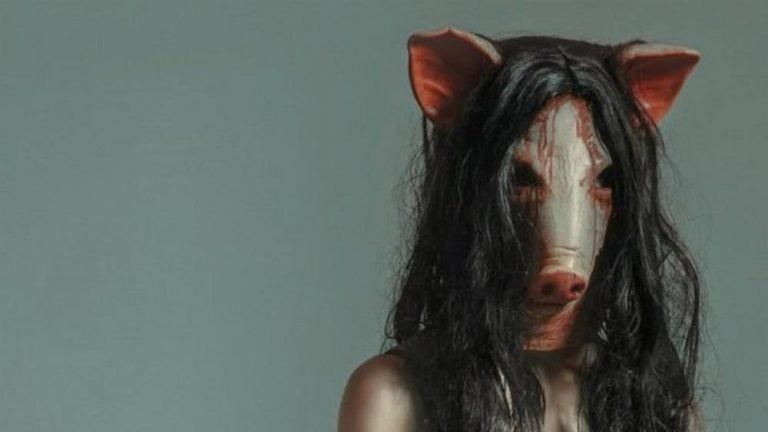For all the conservative fretting that horror movies are depraved, and lacking in clear ethical boundaries, in truth the genre has long flirted with the ultra-moral. Slashers of the ’80s were all about punishing those who transgressed: Jason’s machete-split victims in the Friday The 13th series were a gaggle of drug users, perverts and bullies, and even lesser-known titles like Happy Birthday To Me and Black Christmas subtly railed against the excesses of youth.
For the last 13 something years, the much-maligned Saw series has taken that legacy of black-and-white morality and ramped it up to the Biblical. Jigsaw, the films’ gravelly voiced antagonist, is a kind of substitute God – a deity to deal with all the sinners that the great man in the sky has somehow missed. And for all of the series’ cruelty and toe-curling sadism, at its heart it is as concerned as sorting the goodies from the baddies as a Marvel movie, or a folktale by the Brothers Grimm.
This is a Saw film, so there is a lot not to like about Jigsaw.
Taking that notion to its logical conclusion, Jigsaw, the newest instalment in the franchise, is less a film about the titular serial killer himself, and more about the sect of those who worship him as though he were a literal god. Intertwining the plight of not-so-innocent souls trapped in a torture barn and the throng of stock standard detectives racing against the clock to free them, at its best, the film is an examination of cult-like behaviour – a look at those willing to dedicate themselves to a man who, however brutally, absolved the misguided and reverse bear-trapped the deviant.
Note the use of the phrase “at its best”. This is a Saw film, so there is a lot not to like about Jigsaw – a lot that even fans of the series will have to grit their teeth and pretend to enjoy. There’s the violence, for a start, which is uniformly ugly and unimaginative, and directors Peter and Michael Spierig make the same mistake that every filmmaker associated with the series save for James Wan has made: they confuse the disgusting with the genuinely transgressive.
Despite what the pair clearly think, there is nothing boundary-pushing about watching a woman get hydrochloric acid injected into her neck, or a young man diced up by a glorified fruit peeler – that kind of violence is briefly unpleasant for the time that an audience has to sit through it, then immediately forgettable. It doesn’t speak to some deep mastery of taboos and how to transgress them; it speaks to a puerile misunderstanding of how to push an audience’s buttons. There’s only so many times you can dump a bucket of gore and gristle on your viewers. Before too long they’re just gonna get bored.
Then there’s the glaring lack of style. Say what you want about the first film – at least it had a sense of visual panache, no matter how grotty and neon-lit. By contrast, Jigsaw is about as interesting to look at as a TV movie. It’s all digitally-blurred edges and flat, even lighting, with the booby-trapped barn our heroes must fight their way out of coming across more like a stage in a video game than anything suitably menacing. Even the house in Saw’s creaky second instalment felt like a character unto itself; here, the Spierig Brothers’ mangled handle of tone leaves even the most spiky traps feeling like so much set-dressing.
It’s a rare case in which the audience underestimating the film kinda works in its favour.
But – and this is quite a but – for all its flaws, Jigsaw is bafflingly watchable. Sure, it’s ugly – both ethically and visually – but it does clip along a quite a pace. Neatly sidestepping the convoluted plotting that derailed 2010’s Saw 3D, Jigsaw keeps things as simple as a film of this type can. There is no sudden reappearance of a character only tangentially related to the series; no intersecting storylines; and, just when it looks like the film is ready to start messily retconning its own mythology, a late in the game twist keeps things admirably lean and stripped-down. For the first time since the original Saw, audience members won’t have to start racking their brain trying to work out which Jigsaw acolyte from which movie has suddenly popped up in the third act.
And, about that twist. It might not be as effective as the vicious meathook of an ending that capped off the first film, but Jigsaw’s denouement does have a sick kind of glee all of its own. Sure, it’s essentially a cobbling together of the ending of Saw and Saw II, but, crucially, it doesn’t feel like a cheat, or a rehashing of old glories. The clues really are all there for viewers to put together – sometimes, in fact, shoved right down their unsuspecting throats – making the ending feel as carefully controlled as one of Jigsaw’s elaborate traps.
Better still, the twist actually explains away bumps early on in Jigsaw’s road – moments that feel like glaring oversights on the Spierig Brothers’ part are eventually explained and resolved. It’s a rare case in which the audience underestimating the film kinda works in its favour; you will accept plot holes you might not otherwise have accepted, only later on to discover they’re not really plot holes at all.
Jigsaw is not a great film. To even call it ‘good’ feels too generous. But, in its unfussy meanness, it occasionally scrapes the genius of the original. Let’s just hope the inevitable Jigsaw 2 – dropping October 2019, I’d guess – does the same.
Jigsaw is in Australian cinemas Thursday November 2.


































